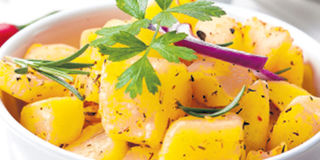Microwave-baked potatoes

Microwave baked potato dish that can be prepared from a microwave oven. PHOTO/FILE
What you need to know:
- However, most people use it to heat beverages or leftover food only, yet it can do so much more, including cook and bake and, in the process, make your life much easier.
- Note that foods with high water density such as fruits and vegetables, cook more quickly. The same applies for foods high in fat and sugar.
The microwave oven is now an essential part our lives.
However, most people use it to heat beverages or leftover food only, yet it can do so much more, including cook and bake and, in the process, make your life much easier.
Safety tips
- After cooking or reheating food in the microwave, it will be hot, therefore use oven pads while removing it.
- If the food is covered during cooking, leave it partially uncovered, to prevent steam from building, which can then scald you.
- Ovens usually have hot spots, therefore if you eat the food directly from the oven, the areas that are superheated will burn you.
- There can also be cold spots where the food does not get hot enough to kill bacteria. To ensure even heating, stir then continue heating until the food is evenly hot.
- Do not use metal containers to warm or heat food; microwaves bounce off metal, which can cause sparks or a fire.
- Ensure that the glass, plastic containers, and plastic wrap you use are labelled “microwave safe”.
- Never operate a microwave if the door is damaged or does not close securely.
- Do not operate the oven while it is empty. This can also start a fire.
- It is advisable to stand a few steps away from the microwave when it is operating — just to be on the safe side.
- When shopping for a microwave, find out how many watts it has. The lower the watts, the longer it will take to cook or heat up food.
- When cooking on any other power level than HIGH, the oven cooks by cycling power on and off, so the energy has a chance to move through the food without overcooking.
- MEDIUM and LOW power are generally used to soften, melt, and defrost foods, while HIGH is usually used for cooking.
Note that foods with high water density such as fruits and vegetables, cook more quickly. The same applies for foods high in fat and sugar.
Cleaning
Use two tablespoons of lemon juice mixed with one cup of water to clean my microwave.
Place the mixture in a measuring cup and microwave on HIGH for 2-3 minutes, until the liquid boils.
Let the liquid remain in the microwave, without opening the door, for five minutes. Remove the measuring cup.
The microwave will easily wipe clean with a paper towel.
Microwave baked potato
Ingredients
Large potatoes
Salt and pepper
Sour cream
Butter
Method
With skin intact, wash the potatoes under running water and pat dry.
Using a fork, pierce the potatoes four times at different points. This is to let the potato “breath” as it cooks.
Place in a microwave-friendly bowl ready for cooking while covered.
Cook in the microwave oven for about five minutes or until the potato is soft on the inside when pressed. You can insert a small knife to check readiness.
Remove from the oven, taking care not to get burnt.
Make an X cut on top of the potato then press with your fingers from either end to open it up, and then season with salt and pepper.
Pocket butter or sour cream into the opening before serving, and enjoy with a salad or on its own.
Chef’s Tips
To check if the dishes you own are microwave-safe, place a cup full of water in the dish you want to test.
Cook at 100 per cent power for a minute. If the water gets hot and the dish you are testing stays cool, it is safe to use in the microwave.
If the dish gets hot, it contains lead or metals and should not be used in the microwave.
Do you want to improve your chapati-making skills? log onto www.nation.co.ke/chapati



